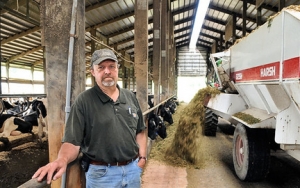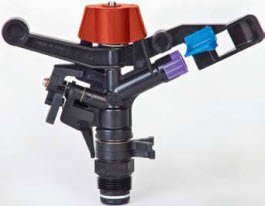The solution for medium and large scale farms
Feeding cows the right stuff keeps Central New York drinking water clean

That is due in large part to the feed eaten by dairy cattle and the amount of manure spread on the land for crops. The work done through the Skaneateles Lake Watershed Agricultural Program involves more than 50 farmers voluntarily helping to keep the lake water quality high.
Other Central New York counties are following similar practices to keep their water pure.
"All the data we have suggests that this is a very successful program, " said Russ Briggs, a forest soils professor at the State University College of Environmental Science and Forestry in Syracuse, who has studied streams entering Skaneateles Lake for four years. "The Skaneateles Lake Watershed Agricultural Program is a model. It is outstanding."
What goes on?
Homer farmer Mike McMahon has about 675 cows on 1,900 acres just outside the village of Homer. He and his father before him have farmed this land for more than 50 years.
McMahon said about 74 percent of his property sits on the aquifer that feeds the Homer municipal water system. Many of these acres also are near a state Department of Environmental Conservation-protected stream -- Factory Brook, which is a headwater of the Chesapeake Bay. The rest of his land is in the Skaneateles Lake watershed.
In the early 1990s, a group of agricultural nutritionists and crop and soil scientists from Cornell began researching ways to reduce phosphorus going into surface water.
Mark Burger, interim executive director of the Onondaga County Soil and Water Conservation Service, said reducing phosphorus is important to water health. "The manure will leach through the soil and come into the water, creating algae," Burger said. "If you have excess nutrients in the water, you have excess vegetation in the water, which then decomposes. This changes the taste and changes the whole chemistry to the water."
He said the excess algae also cuts the oxygen in the water, which kills fish and other aquatic life. He couldn't say if the excess algae would make the water harmful to drink, but "anything could be possible if pushed to an extreme."
McMahon said decades ago, the practice in dairy farming was to spread all the manure on fields every year. But the Cornell researchers thought it would be wise to find out exactly how much manure is needed. "So we started soil sampling on every bit of land here," McMahon said. "We wanted to find out what's in our soil from spreading manure all these years."
What McMahon found was only 25 percent of his 400 low-lying acres "needed a shot of nitrogen, " he said. The rest had all the nutrients needed for crops. So he was able to reduce the amount of manure put on the land, thus cutting the amount of phosphorus and nitrogen that would run off from his land into the nearby watershed.
The researchers also thought the manure should be tested to see how much phosphorus and nitrogen is in it. They changed the feed for McMahon's cows to reed canarygrass, which reduced the amount of phosphorus and nitrogen in the manure.
"Two-thirds to three-quarters of the nitrogen and phosphorus that comes into a dairy farm in the Northeast comes in from purchased food, " said agricultural nutritionist Thomas Tylutki, one of the Cornell researchers who now has his own company.
"Historically, farmers would use a little forage to keep cows healthy and buy everything else, " McMahon said. "We would have 40 percent homegrown feed and 60 percent purchased. Now we've just about flipped that. We have about 70 percent homegrown feed."
So when this manure was spread on fields later on, it had enough nutrients to nourish the soil for crops, but a reduced amount of nutrients to harm the water when it leached to area tributaries and creeks. McMahon said the grass also "made our erosion problem disappear." This also helped keep nutrients such as phosphorus and nitrogen from eroding and ending up in water supplies.
A third aspect to the program is the construction of a manure storage tank on the farm. McMahon said he used to spread manure throughout the winter just to get rid of it and the phosphorus and nitrogen in this manure would seep into the groundwater. Now, with the storage tank, the manure is stored and spread only when it is needed, thus cutting down on seepage into the water.
Elsewhere in CNY
The Skaneateles Lake Watershed Agricultural Program was a pilot for the state's Agricultural Environmental Management program, a voluntary program that helps farmers make farm decisions that save them money and conserve the state's natural resources. These management practices are used throughout Central New York.
In Cayuga County, phosphorus is a problem in both Owasco and Cayuga lakes. In Oswego County, Lake Neahtawanta is suffering from years of phosphorus runoff.
In Madison County, two lakes -- DeRuyter Lake and Oneida Lake -- have been taken off the federal Environmental Protection Agency list of polluted waterways thanks in part to these environmental management practices by county farmers.
"We work extensively with the AEM program and have helped write Comprehensive Nutrient Management Plans for more than 100 dairy farms in Madison County, " said Steve Lorraine, director of Madison County Soil and Water Conservation Service.
"We test the soils every three years and check the fertilizer and the manure, " Lorraine said. "What we do is modeled after the Skaneateles Lake Watershed Agricultural Program."
Ron Podolek, executive director of Cayuga County Soil and Water Conservation Service, said Owasco Lake is showing improvement from efforts such as Agricultural Environmental Management by county farmers. "The No. 1 award in New York state given through AEM was won last year by Fessenden Farms in Cayuga County," Podolek said. "Overall, farmers want to do a good job. AEM is a very beneficial program."
Oswego County doesn't get any of its drinking water from area lakes, said John DeHollander, director of Oswego County Soil and Water Conservation Service. But there still is concern for Lake Neatahwanta, which has severe algae and vegetation problems because of phosphorus coming from many different sources.
Even Lake Ontario had phosphorus problems. "Years ago it was phosphorus-laden, but we've curbed a lot of the phosphorus going into Lake Ontario, " DeHollander said. He said Oswego County also uses Agricultural Environmental Management practices at area farms.




















